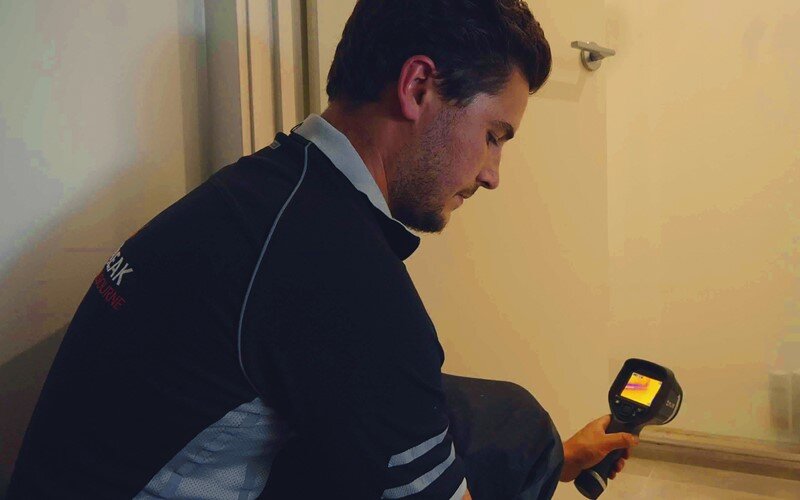Detecting Concealed Water Line Leaks: 6 Clever Hacks
Detecting Concealed Water Line Leaks: 6 Clever Hacks
Blog Article
Almost everyone may have their own thinking in relation to Locating water leaks.

Early detection of dripping water lines can reduce a prospective calamity. Some tiny water leakages may not be visible.
1. Check Out the Water Meter
Every residence has a water meter. Examining it is a proven manner in which assists you discover leakages. For beginners, shut off all the water resources. Make sure nobody will purge, use the tap, shower, run the washing machine or dish washer. From there, go to the meter and also watch if it will certainly change. Considering that no one is using it, there must be no motions. That indicates a fast-moving leak if it relocates. Furthermore, if you spot no changes, wait a hr or two as well as inspect back once more. This suggests you may have a slow leak that can even be underground.
2. Check Water Intake
If you spot sudden changes, in spite of your usage being the very same, it indicates that you have leakages in your plumbing system. An abrupt spike in your costs indicates a fast-moving leakage.
A constant increase every month, also with the very same habits, reveals you have a slow-moving leak that's likewise slowly escalating. Call a plumber to extensively examine your home, particularly if you really feel a cozy area on your flooring with piping below.
3. Do a Food Coloring Test
When it comes to water usage, 30% comes from toilets. If the color in some way infiltrates your bowl throughout that time without flushing, there's a leakage between the container and bowl.
4. Asses Outside Lines
Don't neglect to inspect your exterior water lines as well. Test faucets by affixing a garden hose pipe. Ought to water seep out of the connection, you have a loosened rubber gasket. Replace this and guarantee all links are limited. If you have actually obtained an automatic sprinkler, it will certainly aid get it professionally checked out and also kept annually. One tiny leak can lose tons of water and surge your water costs.
5. Evaluate as well as Evaluate the Situation
Property owners ought to make it a habit to examine under the sink counters as well as also inside cabinets for any kind of bad odor or mold development. These two red flags show a leak so punctual focus is called for. Doing routine inspections, also bi-annually, can save you from a significant problem.
Check for discolorations and compromising as most devices as well as pipelines have a life span. If you suspect leaking water lines in your plumbing system, do not wait for it to escalate.
Early discovery of dripping water lines can minimize a prospective disaster. Some tiny water leaks may not be noticeable. Examining it is a surefire method that assists you find leakages. One tiny leak can throw away bunches of water and spike your water bill.
If you presume dripping water lines in your plumbing system, don't wait for it to rise.
How to Know If Your Home Has a Hidden Leak
Water Meter Reveals Inexplicable Water Usage
If you’d like to test whether or not there’s a leak somewhere in your home, you can do this using your water meter. Here is how to conduct the test:
Don’t use any water in your home for at least 30 minutes; this also means not turning on faucets or water-using appliances.
Go outside, and check your water meter for activity.
If your water meter shows that there was activity, even though no one was using any water, this proves that there is a leak in your home.Visible Mold or Mildew Growth
Leaks behind walls create moist, dark environments that allow mold and mildew to grow and thrive. Eventually, you might see mold growth forming on the wall closest to a hidden leak.
If mold is growing in an area that receives a high amount of moisture, such as a bathroom, it may simply be an indication that better ventilation is needed. However, if you see mold growth on a wall or the ceiling in an area where you would not expect, you probably have a hidden leak.
Musty, Mildew Odor
Sometimes you might not be able to see the mold or mildew that is growing as a result of a leak. However, the smell can give the problem away just as easily. If you catch a whiff of something musty, there’s a good chance that old water is collecting somewhere in your home that you can’t see.
Stained/Warped Walls, Ceilings, or Floors
When your home soaks up water, a variety of red flags can become visible, including ceiling stains, bubbling drywall, warped walls, and sagging floors. While these issues can be caused by excess humidity, they can also be signs that a pipe or plumbing connection has started leaking behind your walls.
Inexplicably High Water Bill
After a while, you get a general sense for what your water bill should be. If you own a pool or sprinkler system, your bill will tend to be higher during summer. However, if you receive a water bill that seems especially high, and you can’t figure out what caused it, then you may have a hidden leak somewhere that’s increasing your bill.
https://www.plumbingjoint.com/blog/2019/july/how-to-know-if-your-home-has-a-hidden-leak/

I am just very interested by Leaking water lines and I hope you enjoyed the new post. If you enjoyed reading our article kindly do not forget to pass it around. We enjoy reading our article about Finding hidden leaks.
Further Details Report this page